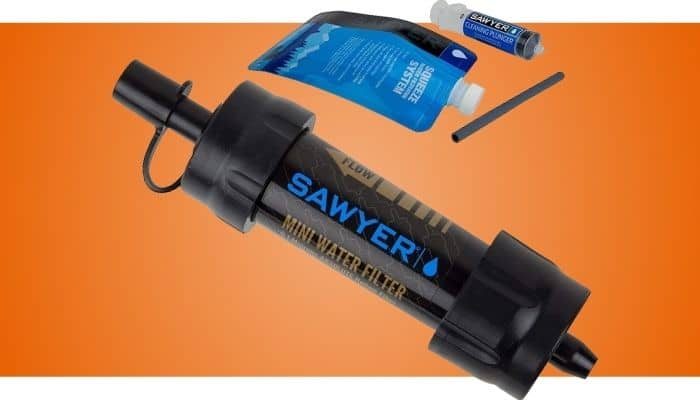
- Ultra-lightweight and Compact: Weighs only 2 oz and is five inches long, making it highly portable.
- Versatile Usage: Can attach to various bottles, hydration bladders, or the included squeeze pouch.
- Effective Filtration: Uses a 0.1-micron hollow-fiber membrane filter to remove bacteria, protozoa, and microplastics.
- Durable and Reliable: No moving parts or batteries needed, easy to clean with the included syringe.
- Affordable: Often priced below $20.
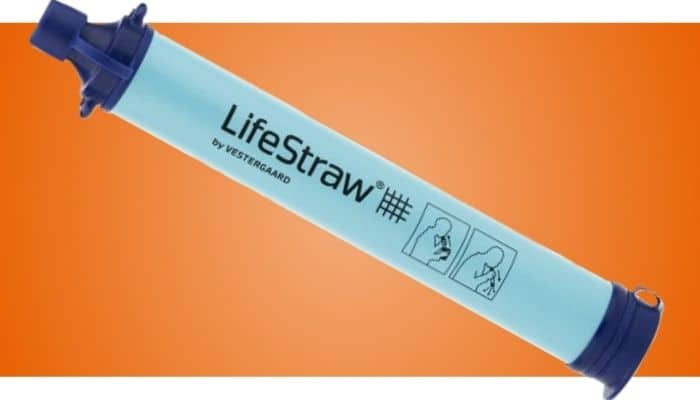
- Lightweight: Weighs less than two ounces.
- High Filter Capacity: Can produce up to 1,000 gallons of filtered water.
- Efficient Filtration: The 0.2-micron filter removes over 99.999% of bacteria and protozoa, and 99.999% of microplastics.
- Simple Design: A straw-style filter, easy to use and carry.

- Lightweight Bottle Style: Weighs 10 oz and is just over a foot long.
- Advanced Filtration: Removes 99.99% of viruses, 99.99999% of bacteria, 99.9999% of protozoa and cysts, and reduces chemicals, heavy metals, and pesticides effectively.
- High Durability: The bottle is rated for 400 fills, and the screw-on Absolute filter has a 100,000-gallon lifespan.
- Easy to Use: Fill, squeeze for 10 seconds, and drink or transfer water.
- Suitable for Global Use: Effective in developing regions and areas with chemically uncertain water sources.
Wherever you are in the world one thing is always true: You’re going to get thirsty. Depending on how far off the map you end up there’s a good chance you’ll need to filter your own water. This is doubly true if you find yourself in certain parts of the developing world with uncertain sources of water. Today we’ll be covering a range of individual water treatment options to find the best portable water filter for your needs.
Contents
- 1 Best Portable Water Filter & Purifier Reviews
- 1.1 Sawyer Products Mini: Overall Best Water Filtration System
- 1.2 LifeStraw Personal Water Filter
- 1.3 Sawyer Products Select Series S3 Water Filter
- 1.4 LifeStraw Go Water Filter Bottles
- 1.5 MSR MiniWorks EX Microfilter Water Filter
- 1.6 Survivor Filter PRO
- 1.7 Sport Berkey Filtered Water Bottle
- 1.8 Survivor Filter PRO X
- 1.9 Katadyn Vario Water Filter
- 1.10 GRAYL Ultralight Water Purifier Bottle
- 1.11 SteriPen Adventurer Opti Water Purifier
- 2 Buyers Guide to Buying the Best Portable Water Filter
- 3 Top Portable Water Filters Video
- 4 FAQ – Best Portable Water Filters
- 5 Best Portable Water Filter & Purifier Recap
- 6 Final Thoughts
Best Portable Water Filter & Purifier Reviews
Everyone is going to have different requirements for a water filter. Solo hikers in North America are going to need a wildly different product to groups of people on a safari in Africa.
We’ve put together a list of highly effective water filters from great manufacturers. They include options rated for virus removal and those optimized for weight and portability.
Sawyer Products Mini: Overall Best Water Filtration System

Having embraced the call of the wild numerous times, I always seek to equip myself with reliable and effective gear. The Sawyer Mini Water Filtration System quickly became an indispensable ally in my outdoor adventures, be it hiking, camping, or setting up camp by the RV.
Right off the bat, the Sawyer Mini’s ultra-lightweight design impressed me. Weighing a mere 2 oz and measuring just five inches long, it nestles in my backpack without adding any noticeable weight. Its compact size, coupled with the variety of attachment options, melds seamlessly with my love for minimalistic yet functional gear.
The versatility of this filter is truly commendable. I’ve had the pleasure of screwing it onto a standard disposable water bottle and utilizing the in-line attachment to filter water straight into my hydration bladder. Its adaptability doesn’t end there; the included squeeze pouch is a fine touch, although a tad small for my liking, it serves well in emergencies.
The effectiveness of the Sawyer Mini in purifying water is nothing short of remarkable. With its 0.1-micron hollow-fiber membrane filter, it confidently sieves out harmful bacteria and protozoa, ensuring that I’m sipping on clean and safe water throughout my trails. The fact that it removes 100% of microplastics is a testament to its filtration prowess.
The durability and reliability of this filter shine through, given its lack of moving parts or batteries. This is a solid piece of equipment that demands little yet delivers much. Cleaning it is a breeze with the provided syringe, even when I’m miles away from civilization.
Now, onto the less gleaming aspects. Filtering larger quantities of water, especially for a group, proved to be a slow and slightly tedious task. And while it’s perfect for on-the-go hydration, collecting and treating larger volumes of water for cooking during long hikes required a secondary treatment system. The cap cover is also easy to misplace, which is a minor gripe, but worth noting.
Despite these minor setbacks, the Sawyer Mini holds a special place in my outdoor gear repertoire. Its affordability is the cherry on top, making it a cost-effective solution to stay hydrated and safe during my outdoor escapades.
During a recent weekend camping expedition in the Rockies, the Sawyer Mini truly proved its mettle. As someone who thrives in the serenity of nature, I had ventured farther from the campsite, finding myself by a tranquil, albeit questionable water source. With the day’s hike taking a toll, my water supply had dwindled faster than anticipated.
The Sawyer Mini came to the rescue. I effortlessly attached it to a disposable water bottle I had, and within moments, I was sipping on clear, refreshing water, the worries of bacteria and other contaminants banished. As I sat there, amidst the untouched beauty of the wilderness, the peace of mind this tiny gadget provided was unparalleled. It was not just about quenching my thirst, but knowing that I could venture into the heart of nature with a reliable companion to safeguard my health. This instance cemented the Sawyer Mini’s place as a permanent resident in my outdoor gear ensemble.
In a nutshell, the Sawyer Mini Water Filtration System is a small, yet mighty companion that I wholeheartedly recommend to any fellow outdoors enthusiast. Its stellar performance, lightweight design, and versatility make it a worthy investment for anyone who, like me, yearns to explore the great outdoors without compromising on safety or convenience.
Pros:
- Ultra-lightweight and Compact: Weighing just 2 oz and measuring five inches, it’s a breeze to carry along on any outdoor adventure.
- Versatile Usage: Can be attached to various bottles, hydration bladders or used with the provided squeeze pouch, making it adaptable to different situations.
- Effective Filtration: The 0.1-micron hollow-fiber membrane filter effectively removes harmful bacteria, protozoa, and microplastics, providing safe drinking water.
- Durable and Reliable: Lack of moving parts or batteries makes it a dependable choice for rugged outdoor use.
- Easy Cleaning: Comes with a syringe for field cleaning, ensuring it remains functional even on extended trips.
- Affordable: With a price tag often below $20, it’s a cost-effective solution for clean water on the go.
Cons:
- Slow Filtration for Larger Volumes: Filtering larger quantities of water can be a slow and somewhat cumbersome process, especially for group outings.
- Small Squeeze Pouch: The included squeeze pouch is somewhat small and might not cater to larger hydration needs.
- Cap Cover Easy to Lose: The cap cover can be easily misplaced, which could potentially lead to contamination.
- Secondary Treatment Needed for Larger Volumes or Cooking: Not ideal for treating larger volumes of water needed for cooking or long hikes without frequent water sources.
- Potential to Entice Less Water Carrying: The convenience might entice individuals to carry less water than needed, relying heavily on finding water sources.
LifeStraw Personal Water Filter

The LifeStraw Personal water filter was designed by Vestergaard Frandsen as a humanitarian aid tool. It weighs less than two ounces yet is capable of producing 1,000 gallons of filtered water.
As the name suggests the LifeStraw is a straw type filter meant to be worn around the neck or placed in a bag. It was designed to provide an individual with 5 years of daily clean water.
The filter element is .2 microns and can remove 99.999999% of bacteria such as E.coli or Salmonella, and 99.999% of protozoan cysts, including Giardia and Cryptosporidium. It also removes 99.999% of microplastics.
The downside to the LifeStraw really comes with all straw style water filters. It doesn’t allow you to filter water to be placed into a container. Any container you store dirty water in will have to be sanitized before you can use it to keep drinking water.
For a lightweight straw type water filter it’s hard to go wrong with the LifeStraw. It’s well made, easy to use, and does a good job filtering most bacterial and protozoan contaminants.
Sawyer Products Select Series S3 Water Filter

The Sawyer Select S3 water filter is a lightweight bottle style filter designed for use all over the world. It uses a two part filtration system combining a foam membrane in the purifier bottle with Sawyer’s hollow-fiber absolute filter.
It weighs just 10 oz and is just over a foot long fully assembled. This allows you to pack it just about anywhere.
The filters themselves are capable of removing 99.99% of viruses, 99.99999% of bacteria, 99.9999% of protozoa and cysts. Testing has shown it to be capable of reducing chemicals, heavy metals, and pesticides to less than .05 parts per billion and .01 parts per billion, well under the EPA’s limits for public tap water.
This makes it suitable for use in the developing world or even in chemically uncertain water sources.
The filter bottle is rated to 400 fills while the screw on Absolute filter has Sawyer’s standard 100,000 gallon lifespan. We found actually using it to be pretty easy. Just fill the bottle up to the max line on the side and squeeze it in an alternating motion for 10 or more seconds.
After that you can drink through the squeeze top or use it to fill another bottle. It’s priced on the high side for a bottle filter but given how effective it is we can understand why.
If you’re planning a trip to the developing world or another location with highly uncertain water supplies the Sawyer Select 3 is a great water purification system to take with you.
LifeStraw Go Water Filter Bottles
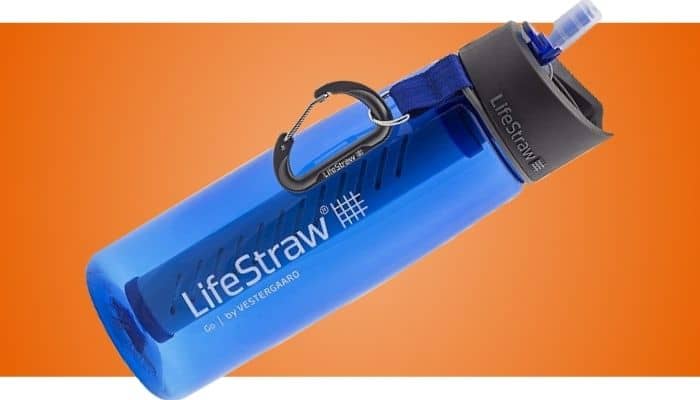
The LifeStraw Go is a bottle style filter based on the original LifeStraw. It uses an identical filter element fitted into a BPA-free reusable 22 oz bottle.
The filter element is capable of removing 99.999999% of bacteria such as E.coli or Salmonella, and 99.999% of protozoan cysts, including Giardia and Cryptosporidium. It also removes 99.999% of microplastics.
One change the LifeStraw Go makes is the inclusion of a 25 gallon activated carbon filter. This helps improve the taste of your water. The main filter has the same 1,000 gallon lifespan of the original LifeStraw
The whole system weighs just under 8 oz and provides you with excellent drinking water from uncertain sources. It isn’t rated to remove viruses but as long as you’re using it in North America or Western Europe this shouldn’t be too big an issue.
As with most bottle and straw style filtration systems the biggest downside is the inability to filter more than a single bottles worth of water. You can’t use the LifeStraw Go to filter water for cooking as an example.
The LifeStraw Go is a lightweight and inexpensive water filtration system rated to remove bacteria and protozoan cysts. It isn’t suitable for use in the developing world but does a great job for general hiking, camping or survival purposes.
MSR MiniWorks EX Microfilter Water Filter
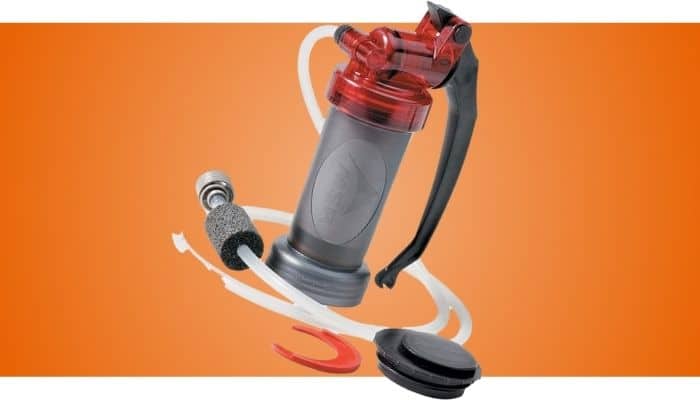
The MSR MiniWorks EX Microfilter is a pump style water filter designed for hiking and camping use. It weighs one pound and is capable of producing a flow rate of a liter per minute after being primed.
It uses a carbon/ceramic combination filter that can remove 99.9999% of bacteria and 99.9% of protozoan cysts. The carbon filter also helps improve the taste of the water.
It has a small pre filter element at the end of its intake tube and is sized to screw securely onto MSR’s Dromedary bags for ease of use. The pump itself is designed with an Airspring Accumulator system that improves the flow rate as you build up pressure.
The MiniWorks EX requires no tools to maintain and has a filter capacity of just over 500 gallons. Pricing wise it’s definitely on the expensive side—Usually being priced right around $100.
Overall the MSR MiniWorks EX is a quality pump style filter with a good flow rate. If you specifically want a pump filter over a squeeze or straw type it’s a good option.
Survivor Filter PRO
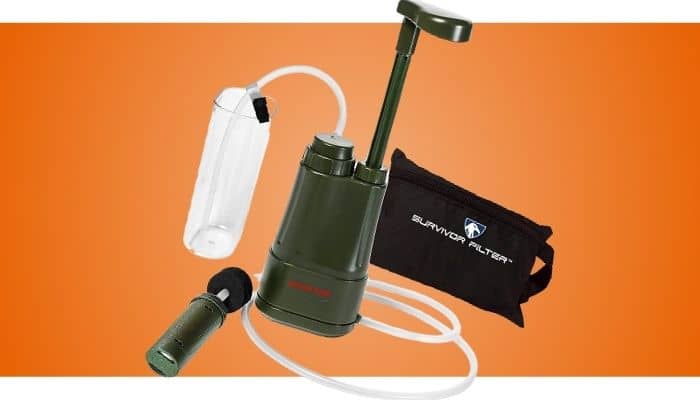
The Survivor Filter PRO is a pump style water filter designed for the preparedness and emergency response market. It’s made up of a pump, a prefilter element, and a three step filter system.
The prefilter does a good job at removing larger particles such dirt or leaves. Where the PRO really shines is in its three step filter system. It’s rated to remove 99.999% of bacteria, protozoan cysts and viruses. Testing has also shown that it can remove 99.5% of mercury and 93% of lead in contaminated water.
One primed it’s capable of producing .5 liter of water per minute. This is suitable to fill up several water containers in a reasonably short time.
That makes the Survivor Filter Pro suitable for use all over the world. It’s definitely heavier than squeeze or straw filters, weighing 12.8 oz, but is on the lighter side for a pump. At just 6.5 inches long when packed it’s easy to take it anywhere you want to go.
If you’re planning a trip to Africa or another part of the developing world the Survivor Filter PRO should definitely be on your shortlist for filters.
Sport Berkey Filtered Water Bottle
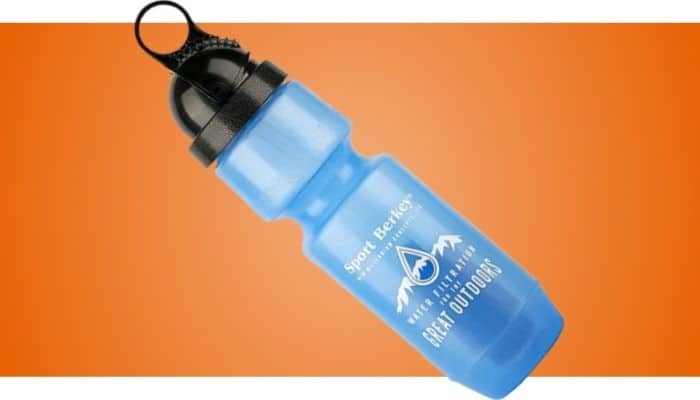
Berkey is one of the biggest names in the off-grid and preparedness communities. They make a wildly popular series of large gravity-fed filters and have started to branch out into more portable hiking and camping models.
The Sport Berkey filtered water bottle is built around Berkey’s proprietary Black Berkey filter elements. It comes in a 22 oz BPA-free water bottle that’s just 11 inches long and weighs just a few ounces.
Where the Sport Berkey really shines is in its filter element. The mini Black Berkey filter is capable of removing 99.9% of bacteria, protozoan cysts, chemicals, pesticides, pharmaceutical contaminants, and heavy metals. It’s also able to remove 97% of viruses present.
This makes the Sport Berkey just about the most effective individual water filter available. There is a downside to this unfortunately. When filtering water from uncertain sources the Black Berkey filter elements have a lifespan of just 25 gallons.
It’s priced right alongside other squeeze and straw style water filters with replacement filters about half the cost of a new bottle. If you need that level of filtration it can definitely be worth it.
Overall the Sport Berkey filtered water bottle is one of the most capable water filtration options available. It’s reasonably priced and suitable for use just about anywhere on the planet.
Survivor Filter PRO X
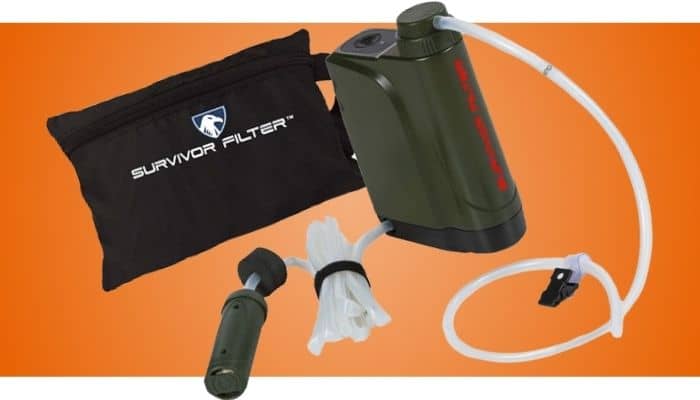
The Survivor filter PRO X is a really exciting new filter from the makers of the original Survivor Filter PRO. It uses an identical filtration system but pairs it with a battery operated pump.
This allows you to pump up to 17 oz of water per minute through the highly effective three stage filter system. As with the PRO, the PRO X’s filter can remove 99.999% of bacteria, protozoan cysts and viruses. It can also reduce the levels of heavy metals by up to 99.5% of mercury and 93% of lead.
The filter element has the same capacity as the PRO and runs off of AA batteries. In difficult conditions one set of batteries will give you 12000 oz of water.
We’ll be honest though, the PRO X is expensive. Noticeably more expensive than just about any comparable filter on the market. If the lack of pumping and high flow rate is important to you though the Survivor Filter PRO X is a good option.
Katadyn Vario Water Filter

The Katadyn Vario is a pump water filter designed for hiking and camping use. It has a two stage filter system that can be switched on or off to improve filter life or flow rate.
It has a prefilter element on the end of the intake tube that helps remove leaves and other debris. The main filter is a replaceable .2 micron glass fiber filter. There’s an optional ceramic filter that can help improve filter life. It’s capable of removing bacteria and protozoan cysts but not viruses, heavy metals or chemicals.
The Vario weighs 15 oz and is 6.5 inches long. It needs to be cleaned and serviced after each trip, a process requiring partial disassembly.
The Katadyn Vario is part of the old guard of pump style water filters. There was a time where it would have topped the list of just about any hiking and camping water filter but it’s since been surpassed. The best squeeze style filters are lighter, less expensive, easier to maintain, longer lasting, and just as effective at filtering water as the Vario.
If you really need a pump water filter the Katadyn Vario is a great option. Otherwise you should definitely go with a squeeze or straw style filter.
GRAYL Ultralight Water Purifier Bottle
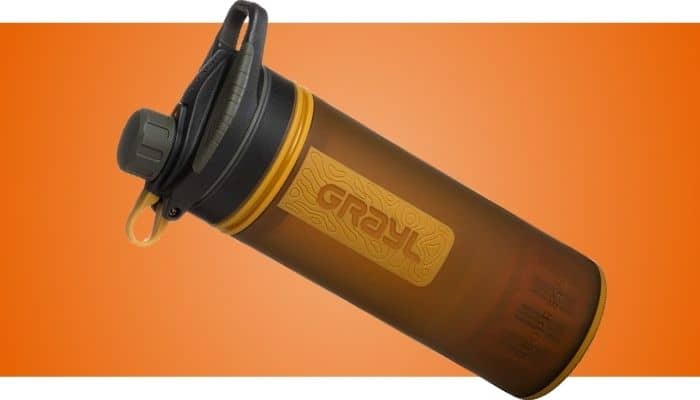
The GRAYL Ultralight is a water purifier bottle designed for use all over the world. It uses GRAYL’s unique GeoPress filtration process that eliminates pumping or the need to suck or squeeze water through a filter.
The filter itself is rated to remove 99.9999% of viruses and bacteria as well as 99.999% of protozoan cysts. It has also been shown to greatly reduce the levels of chemicals and heavy metals in your water.
The filter element is good for up to 40 gallons, not bad at all for a water purification system capable of removing viruses.
The bottle itself weighs just 10.9 oz and is capable of filtering up to 16 oz of water at once. Because of the unique press design you can filter water to pour into other containers or drink straight from the bottle.
The GRAYL is priced on the premium end of the market and the filter refills similarly aren’t cheap. For how effective it is though we definitely understand.
If you’re planning a significant trip to the developing world the GRAYL Ultralight is a great water filtration option.
SteriPen Adventurer Opti Water Purifier

The SteriPen is a water purification system that uses intense UV light to kill bacteria, protozoans, and viruses. It weighs just 3.8 oz and is rated to purify up to 8,000 liters of water on a single bulb.
It runs on 2 CR123 lithium batteries rated to provide 50 liters of water before needing replacement. As a UV purifier it doesn’t filter anything out of the water.
It works best when paired with another lightweight water filter that removes the bulk of particulates and other materials. The UV finishes things off and kills the remaining bacteria.
A couple things to keep in mind with the SteriPen or any UV purifier. It only works in clear water. If the water is clouded with dirt or other debris the light can’t penetrate to kill the biological contaminants.
It also doesn’t remove the remaining dead bacteria after they’ve been killed.
If you’re looking for an all in one purification method the SteriPen isn’t it. If, on the other hand, you want a purifier to pair with a filter you already own it’s a great option.
Buyers Guide to Buying the Best Portable Water Filter
Water filters have never been more capable. The market is flooded with high-quality filters at very affordable prices.
That creates its own problem though. Picking out the best filter for your specific needs can feel almost overwhelming.
Below we cover the most important factors that go into how effective a water filter will be for your specific situation.
| More Great Hiking Gear |
|---|
| Hiking Bandana |
| Top Hiking Daypack |
| Strong Hiking Poles |
| Best Waist Packs for Hiking |
| Best GPS Watch for Hiking |
Price
Water filters have drastically dropped in price over the last decade or so. You can get highly capable water filters that weigh next to nothing for $50 to $100.
Some of the very best actually cost under $30.
Weight and Size
In the past water filters relied on hefty pump systems to force dirty water through a filter. No the best systems use gravity or the suction created through a straw to move water.
This allowed filters to get lighter and lighter. Some of the very best on the marker weigh just one to two ounces. Even filters built into water bottles weigh well under a pound.
Filtration Speed
The filtration speed of a water filter measures how much clean water you can produce over the course of an hour. It’s most commonly referenced in gravity-fed and pump based water filtration systems.
For most gravity-fed filters you’re looking at about one to two gallons an hour. Squeeze pouch and pump systems can usually filter substantially more water per hour than can a gravity fed.
You should have no problem filling multiple water bottles or even gallon jugs.
Filter Capacity
Filter capacity is one of the most important metrics to look at when comparing different filters. Some filters have usable lifespans in the thousands or even tens of thousands of gallons.
Others will only last for a few hundred.
Make sure you compare their filter capacity to their intended use before you pass judgement. Some of the highest capacity filters don’t remove nearly as many contaminants as the lower capacity ones.
Ease Of Use
Modern water filters have never been easier to use or care for. The majority of top quality filters on the market today come in three forms:
- Straw/Bottle Filters
- Squeeze Filters
- Pump Filters
Pump filters were once the most common form of water filter but have long since been supplanted by squeeze and straw filters. They’re heavy, usually weighing at least a pound, and take up a lot of space in your bag.
They also don’t produce water as easily or as quickly as straw or squeeze filters.
Straw filters are exactly what they sound like—a straw with a filter built in. They’re lightweight, portable, and work with any water bottle or by drinking directly from a source of water.
To keep them at their best all you need to do is blow the water back out of filter when you’re done drinking.
Squeeze filters are undeniably the easiest and most versatile to use. They’re featherlight, usually weighing barely an ounce or two, and designed to attach to a wide variety of containers.
You can use a squeeze filter as part of a gravity fed filtration setup, on top of a standard disposable water bottle, or with a squeeze pouch to fill any container you like. Maintaining them is just as easy. Simply flip them around and push clean water through the filter a few times.
They’re easy to use, inexpensive, and produce a lot of water as fast as you can squeeze it out. The majority are rated as water filters rather than purifiers but there are some highly capable versions.
There’s also a subcategory of water purifiers that rely on UV light to kill bacteria, viruses, and protozoan cysts.
Filters vs Purifiers
First time hikers and seasoned outdoorsman alike are often confused by the difference between a water filter and a water purifier. When it comes right down to it there’s only on difference that matters.
Water filters use a physical filtration medium to remove bacteria and protozoan cysts. Water purifiers do the same thing, but also remove tiny viruses.
In North America and Western Europe you usually don’t need more than a water filter. We’ll explain more in depth why that’s the case below.
Bacteria – The most common waterborne pathogens hikers and campers have to worry about are bacteria. These include E. coli, Salmonella, Campylobacter and Shigella.
Just about any water filter is going to be able to remove bacteria at a very effective level. Even in the developed world sources of water will be contaminated with bacteria.
Protozoan Cysts – Protozoan cysts include things like Cryptosporidium and Giardia lamblia. These can cause serious gastrointestinal distress if contracted. Thankfully any quality water filter is able to remove protozoan cysts due to their large size.
These are also prevalent in the developed and developing world.
Viruses – Waterborne viruses capable of sickening humans aren’t as common as you’d think. Viruses can’t survive in most types of water for long. The sun beating down on the water deactivates many more. Common examples of these viruses include hepatitis A, rotavirus and norovirus.
It’s really only in the developing world without effective and widespread sewage treatment facilities that viruses become an issue.
If you’re planning to travel somewhere like Africa or Central/South America you should invest in a full water purification system rather than just a filter.
Chemical Contaminants and Heavy Metals – We strongly recommend that you not drink from any source of water you believe is contaminated with chemicals or heavy metals.
If there’s no other choice you need to make absolutely sure that you have a comprehensive water purification system rated to remove things like agricultural runoff, lead, arsenic, and other dangerous contaminants.
There are only a few such systems available, so make sure you do your research when picking on out.
Consider a Prefilter
In the past, virtually every water filter had a pre filter element that helped remove large particles before it reached the actual filter. With the rise of straw and squeeze filters these are much less common.
A great way to improve the working life of your filter is to run water through a basic pre filter before you put it through the filter itself. A great way to do this is to put a handkerchief or other piece of cloth across the opening of your water container.
When you fill it up from a stream or other source of water this reduces the large particles that have to be removed by your filter.
Top Portable Water Filters Video
FAQ – Best Portable Water Filters
When it comes to camping, having access to clean drinking water is an absolute necessity. While the great outdoors offer breathtaking landscapes and thrilling adventures, the water sources found in nature can often be contaminated with bacteria, protozoa, and other impurities that pose health risks. That’s where portable water filters come to the rescue.
In this section, we have compiled a list of frequently asked questions to provide you with valuable insights into the world of portable water filters. Whether you’re a seasoned outdoor enthusiast or a novice camper, these questions will address common concerns and help you make informed decisions about choosing and using the best portable water filter for your camping needs.
From understanding how portable water filters work to learning about their filtration capabilities and maintenance requirements, we’ve got you covered. So, before embarking on your next camping adventure, take a few minutes to explore this FAQ section and equip yourself with the knowledge you need to ensure a safe and enjoyable experience with clean drinking water.
Why should I use a portable water filter while camping?
A portable water filter is essential for camping as it allows you to purify water from various sources, such as rivers, lakes, and even tap water, making it safe to drink. This ensures you have a constant supply of clean drinking water during your camping adventures.
How does a portable water filter work?
Portable water filters use various filtration methods, including activated carbon, ceramic filters, and hollow fiber membranes, to remove impurities and contaminants from the water. These filters physically trap bacteria, protozoa, sediment, and some viruses, effectively purifying the water.
What types of contaminants can a portable water filter remove?
Portable water filters can effectively remove bacteria, protozoa, cysts, sediments, and some viruses from the water. They also eliminate unpleasant tastes, odors, and chemicals, such as chlorine and heavy metals, making the water safe and enjoyable to drink.
Are all portable water filters the same?
No, portable water filters vary in terms of filtration methods, filter size, flow rate, and overall design. Some filters are better suited for backpacking and hiking due to their compact size and lightweight design, while others are more suitable for larger groups or extended camping trips.
How often should I replace the filter element?
The frequency of filter replacement depends on the specific filter model and the water conditions you encounter. Generally, filter elements should be replaced after filtering a certain volume of water or after a specific duration recommended by the manufacturer. It’s crucial to follow the guidelines provided by the manufacturer to ensure optimal filter performance.
Can portable water filters remove chemicals and heavy metals?
Certain portable water filters, particularly those with activated carbon elements, can effectively reduce or remove certain chemicals and heavy metals from the water. However, it’s important to check the specifications of the filter to ensure it can handle the specific contaminants you may encounter during your camping trips.
How do I clean and maintain a portable water filter?
To maintain your portable water filter’s performance, it’s crucial to follow the manufacturer’s instructions for cleaning and maintenance. Most filters can be cleaned by backflushing with clean water or by using a cleaning kit provided by the manufacturer. Regular maintenance ensures that your filter continues to provide safe drinking water.
Can portable water filters be used in extreme temperatures?
Most portable water filters are designed to function within a certain temperature range. However, extreme temperatures, particularly freezing temperatures, can damage the filter elements. It’s important to check the manufacturer’s guidelines to determine the temperature limits of your specific filter model and take necessary precautions when camping in extreme conditions.
Are portable water filters suitable for international travel?
Yes, portable water filters are highly recommended for international travel, especially to regions where the water quality may be questionable. They provide an effective and convenient way to purify water from various sources, ensuring you have access to safe drinking water wherever you go.
Can I drink water from natural sources without using a portable water filter?
While it’s possible to drink water from natural sources without a portable water filter, it comes with risks. Natural water sources can contain harmful bacteria, parasites, and other contaminants that can lead to waterborne illnesses. Using a portable water filter adds an extra layer of protection, ensuring the water is safe for consumption.
Remember, it’s important to research and choose the best portable water filter that suits your specific needs and camping style. Always refer to the manufacturer’s instructions and guidelines for proper usage and maintenance of the filter.
Best Portable Water Filter & Purifier Recap
- Sawyer Products Mini: Best Portable Water Filter

- LifeStraw Personal Water Filter

- Sawyer Products Select Series S3 Water Filter

- LifeStraw Go Water Filter Bottles
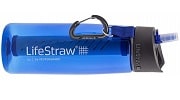
- MSR MiniWorks EX Microfilter Water Filter

- Survivor Filter PRO Portable Water Filter

- Sport Berkey Filtered Water Bottle

- Survivor Filter PRO X Portable Water Filter

- Katadyn Vario Portable Water Filter

- GRAYL Ultralight Water Purifier Bottle
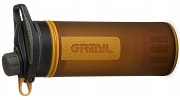
- SteriPen Adventurer Opti Water Purifier

Final Thoughts
There are a lot of great water filters out there. Picking out the best portable water filter isn’t about finding a good one from the bad ones, but finding the perfect one for you from excellent choices.
If you plan to spend time in the developing world it’s hard to go wrong with the Sport Berkey. It’s lightweight, relatively inexpensive, and highly effective at removing biological and chemical contaminants.
In the end though there was a clear winner.
The Sawyer Mini.
It’s hard to overstate how awesome the Sawyer Mini is. It’s lightweight, highly effective, costs next to nothing, and works with just about any type of water bottle or pouch.
We’ll be honest, you’re more likely to lose it before you wear out this wonderful little filter.
Just used the Sawyer Mini on a 3-day backpacking trip. It’s incredibly light and compact, fitting easily in my pack. The water flow rate is decent, but it takes a bit of effort for larger volumes. I especially like how it attaches to standard water bottles. For the price, it’s a fantastic value. Only downside is the squeeze pouch’s limited capacity. Overall, 4.5/5 stars!
Great roundup of filters! I’ve used the Sawyer Mini for years, never lets me down on hikes.